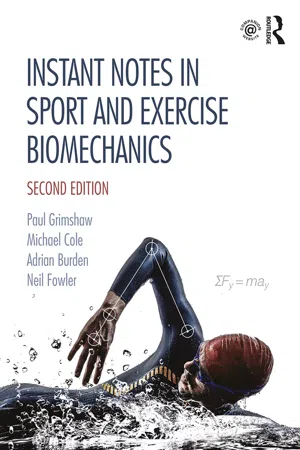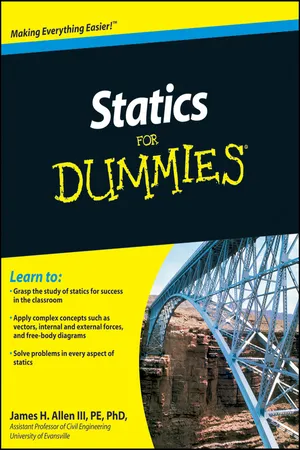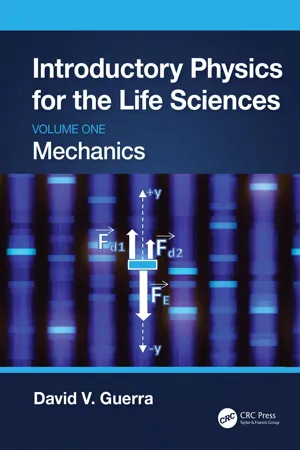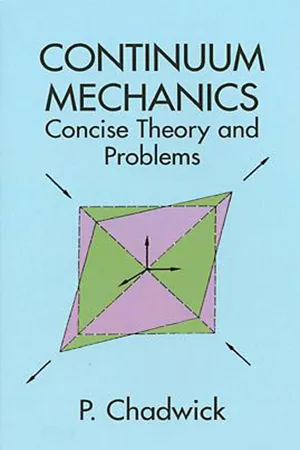Physics
Moments and Equilibrium
Moments in physics refer to the turning effect of a force around a pivot point. Equilibrium occurs when the sum of all the clockwise moments about a pivot point is equal to the sum of all the anticlockwise moments. This means that the object is not rotating and is in a state of balance.
Written by Perlego with AI-assistance
Related key terms
Related key terms
1 of 4
Related key terms
1 of 3
6 Key excerpts on "Moments and Equilibrium"
- eBook - ePub
Instant Notes in Sport and Exercise Biomechanics
Second Edition
- Paul Grimshaw, Michael Cole, Adrian Burden, Neil Fowler(Authors)
- 2019(Publication Date)
- Garland Science(Publisher)
the second condition of equilibrium states that the sum of all the torques acting on an object is also zero. Since the second condition of equilibrium is related to torque or turning moments we can write the second condition of equilibrium as:The sum of the anti-clockwise moments and clockwise moments about a point (rotational point) is equal to zero.Since we know that torques cause rotation and are vector quantities (with magnitude and direction) we can use this knowledge to expand the second condition of equilibrium as follows:where:Σ ACWM + Σ CWM = 0Σ = the sum ofACWM = anti-clockwise moments (+ ve)CWM = clockwise moments (–ve)In this context, it is important to point out that this is referring to a system of torques about a common axis of rotation. Hence, it is important to use the same origin (point of rotation) for anti-clockwise and clockwise moments in the calculation of the second condition of equilibrium. In the example in Figure C3.5 , we had a system with two moments (remember that we are ignoring the moment caused by the weight of the radius and ulna) that were acting about a single axis of rotation (a common axis or origin), which was the elbow joint.Consider the example in Figure C3.5 , with the arm held in the 90-degree flexion position. The moments for this example (ignoring radius/ulna weight) can be seen in Figure C3.6 - eBook - ePub
- James H. Allen(Author)
- 2010(Publication Date)
- For Dummies(Publisher)
Summing moments: Writing the rotational equilibrium equationNotice, however, that I haven’t included the concentrated moment in either of these translation equations. Concentrated moments show up only in the rotational equilibrium equation because they’re rotational behaviors — they don’t show up in the translation equations. However, as you see in the following section, both concentrated and distributed forces show up in the moment equilibrium equations.The third equation that you need to write is the rotational equilibrium equation. This equation behaves a bit differently because, unlike the sum of forces equations that you just wrote, the moment equation requires you to pick a specific point about which you calculate the equivalent resultant moments for the system.For the sake of this example, I arbitrarily choose Point B from Figure 17-1 as the location and see what happens. (If you want to see an even easier way to solve this problem, skip ahead to the “Choosing a Better Place to Sum Moments” section later in the chapter.) You calculate the equivalent moment of each of the actions on the structure about Point B as shown in Figure 17-3.Assuming a counterclockwise moment to be positive, the rotational equilibrium equation about Point B isFigure 17-3: Super-position of forces about B.Each term in the moment equation is the equivalent moment of an action about Point B (which is the point you’re summing moments about). Each force (or components) is included in the expression and includes the perpendicular distance to Point B. If it causes a rotation in the opposite direction, you include a negative sign before that term. A concentrated moment (40 kip per inch, in this example) is included in the equilibrium equation as a single value. It is added (or subtracted depending on its direction of rotation) to the equation directly.If you have a concentrated moment, this value does not require an associated distance. A moment is a free vector, and its equivalent moment at any location is the same as the original moment. The sign before this term in the equation is based on the assumed positive direction of rotation. - David V. Guerra(Author)
- 2023(Publication Date)
- CRC Press(Publisher)
No matter how many equal parts a uniform bar is divided up into the center of mass will always be at the center. For objects that are not uniform, the center of mass will need to be measured or if the function that described the object is known an integral needs to be used in a process like the one described for the uniform bar, but with different values for each part of the object. It cannot be assumed that the center of mass is at the center of the object that is not uniform.3.5 Rotational Equilibrium
In Chapter 2 , translational equilibrium was defined as the condition in which all the forces in each coordinate direction add to zero. In some situations, translational equilibrium is not enough to explain what is happening. For example, if the bar in Figure 3.12 is 10 m long and pinned at its center, it is free to rotate in the x-y plane about its center, and 10 N forces are applied to each end as shown in the figure, the bar would be in translational equilibrium, but it would not be at rest.FIGURE 3.12 Bar in translational equilibrium but not in rotational equilibrium.It is obvious that the bar would rotate counterclockwise about the center. Thus, to understand this situation, another condition is needed. This additional condition for this system is rotational equilibrium.Similar to translational equilibrium of forces, rotational equilibrium is the sum of all torques adding up to zero, this can be written mathematically in equation (3.6) as(3.6)= 0 , which means that ∑τ ⇀Netτ ⇀= 0which states that the sum of the torques acting on an object in equilibrium must equal zero. For the problems in this text, all the forces will lie in the x-y plane, so all the torques will be parallel to the z-axis so the relevant torque component equation for rotational equilibrium will be given by equation (3.7) as:which states that the sum of the z-components of the torques acting on an object in equilibrium must equal zero.(3.7)τ Net, z= 0 which means that∑= 0τ z3.5.1 Rotational Equilibrium Concept Map
In Figure 3.13- eBook - ePub
Continuum Mechanics
Concise Theory and Problems
- P. Chadwick(Author)
- 2012(Publication Date)
- Dover Publications(Publisher)
Chapter 3BALANCE LAWS, FIELD EQUATIONS AND JUMP CONDITIONSClassical continuum mechanics rests upon equations expressing the balances of mass, linear momentum, angular momentum and energy in a moving body. These balance laws apply to all material bodies, whether fluid or solid in composition, and each one gives rise to a field equation, holding on the configurations of a body in a sufficiently smooth motion, and a jump condition applying on surfaces of discontinuity. Like position, time and body, the concepts of mass, force, heating and internal energy which enter into the formulation of the balance laws are regarded as having a primitive status in the mechanics of continua to the extent that they are not defined in terms of ideas considered more fundamental.1 In this chapter we are chiefly concerned with the balance laws and the associated field equations and jump conditions, but prominence is also given to the theory of stress which, besides providing results essential to the development of the field equations, is of basic importance in the analysis of force.1MASSAt the intuitive level mass is perceived to be a measure of the amount of material contained in an arbitrary portion of a body. As such it is a non-negative scalar quantity independent of the time and not generally determined by the size of the configuration occupied by the arbitrary sub-body. Furthermore, the mass of a body is the sum of the masses of its parts. These statements can be formalizedmathematically by characterizing mass as a set function with certain properties and we proceed on the basis of the following definition.Let B be an arbitrary configuration of a body and let A be a set of points in B occupied by the particles in an arbitrary subset of . If with there is associated a non-negative real number - eBook - ePub
- A. L. Stanford, J. M. Tanner(Authors)
- 2014(Publication Date)
- Academic Press(Publisher)
Newton’s second law, Σ F = m a, incorporates the fact that a static body, since it is not moving and therefore has no acceleration, has no net force acting on it. This is a condition of static equilibrium. We now know, however, that a body may have a net force equal to zero yet may not be static; it may, in fact, be undergoing rotation (look at Figure 4.14[a], for example). Consequently, for a body to be in static equilibrium, we must impose an additional condition: The net torque on the body must be zero. Here we may ask, “About what axis should the torques on the body be calculated? About what axis is the net torque equal to zero?” These questions may be answered by a question, “About what axis is the body not rotating?” Clearly, if the body is static, it is not rotating about any axis. Therefore, the net torque on a static body caused by all the forces on that body must be equal to zero when calculated using any axis. This condition, which pertains to any axis, may be expressed by Σ τ = 0 (4-33) (4-33) This means that, for any given arbitrary axis, all the forces acting on a body in static equilibrium produce torques about that axis, the magnitudes of which sum algebraically to zero. An astute reader could ask about a body in static equilibrium, “How do 1 know that if the torques sum to zero about a given axis and the forces sum to zero, the torques will sum to zero about any other axis?” We have not addressed this point, but Problem 4.47 provides the opportunity to convince yourself of its validity. A body in static equilibrium, then, is subject to two conditions of equilibrium, both of which must be satisfied - eBook - ePub
OAT Prep Plus 2023-2024
2 Practice Tests + Proven Strategies + Online
- (Author)
- 2023(Publication Date)
- Kaplan Test Prep(Publisher)
In order for the seesaw to be balanced, the moment (torque) due to the girl must be exactly counteracted by the moment due to her father. More generally stated, the sum of the moments about any point must equal zero.Taking moments about the fulcrum, with the subscript f denoting the father and the subscript g denoting the girl, gives:The problem can actually be solved by taking moments about any point, not just the fulcrum. However, doing so is usually more complicated because the force of the fulcrum on the seesaw first has to be determined.7.10π sStart with centripetal acceleration: a = v2 /r. Given r = 100 m and a = 4 m/s2 , we have v = 20 m/s. Velocity, v, and time of revolution, T, are related by v = 2πr/T; i.e., in a time equal to one revolution, the distance covered is the circumference. Thus, T = 2π(100)/20 s = 10π s.8.The speed of the planet decreases.The force on the planet due to the star is: Since this force provides the centripetal force, it’s also true that F = mplanet v2 /r. Equating the two expressions for F gives v2 = Gmstar /r. Increasing the distance between the planet and the star then means the speed of the planet, v, decreases.Passage contains an image
[ CHAPTER 66 ]
ENERGY AND MOMENTUM
LEARNING OBJECTIVES
After this chapter, you will be able to:- Calculate work on or by a given system
- Apply the concepts of conservation of energy to solve for unknown variables
- Apply the law of conservation of momentum to solve for unknown momentum
- Determine the center of mass of an object
This chapter reviews the fundamental concepts of energy and momentum and the associated concepts of work and impulse. Essentially, work is responsible for changing the energy of an object, and impulse is responsible for changing the momentum of an object. Regarding energy and momentum, the laws of conservation of energy and conservation of momentum are discussed along with concrete examples of problems that make use of these laws for their solution. The topic of collisions is discussed in detail as the most common example on the OAT of the application of conservation of momentum. The concept of work is applied to the problem of pulley systems, resulting in the definition of the efficiency of a simple machine. The chapter closes with a review of the equivalent concepts of center of mass and center of gravity.
Index pages curate the most relevant extracts from our library of academic textbooks. They’ve been created using an in-house natural language model (NLM), each adding context and meaning to key research topics.
Explore more topic indexes
Explore more topic indexes
1 of 6
Explore more topic indexes
1 of 4





